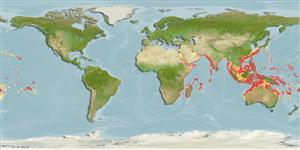Common names from other countries
Environment: milieu / climate zone / depth range / distribution range
экология
; пределы глубины 0 - 900 m (Ref. 4). Tropical; 35°N - 32°S, 31°E - 134°W (Ref. 4)
Indo-Pacific: from South Africa to Hawaii, including Red Sea and Persian Gulf, from Japan to Australia.
Length at first maturity / Size / Вес / Возраст
Maturity: Lm 7.8, range 8 - ? cm Max length : 40.0 cm TL самец/пол неопределен; (Ref. 4)
Minimum depth from Ref. 96667. It has a maximum total body length of 40 cm, and an average length less than 30 cm (Ref. 4). Maximum depth from Ref. 105426. It occurs in shallow water, from the sublittoral down to 15 m; in coral reef areas, often on seaward edges of the reef plateau; in clear water also in surf areas. The species is nocturnal and not gregarious; in daytime, it hides in crevices and cavities of the rocks (Refs. 4, 9773). In general, palinurids are mainly considered carnivores, usually feeding upon sluggish, easily captured animals where most material is eaten alive or freshly killed (Ref. 105260). Feeds on bivalve mollusks and sea urchins (Ref. 9773).
Members of the order Decapoda are mostly gonochoric. Mating behavior: Precopulatory courtship ritual is common (through olfactory and tactile cues); usually indirect sperm transfer.
Основная ссылка
ссылки | координатор | соавторы
Holthuis, L.B. 1991. (Ref. 4)
Статус Красного Списка МСОП (Ref. 130435)
Статус СИТЕС (Ref. 108899)
Not Evaluated
Not Evaluated
Использование человеком
рыболовство: коммерческий
| FishSource | Sea Around Us
инструменты
дополнительная информация
ресурсы в Интернет
Estimates based on models
Preferred temperature
(Ref.
115969): 9.8 - 22.9, mean 15.4 (based on 644 cells).
устойчивость к внешним воздействиям
средний (среднего размера), минимальное время удвоения популяции 1.4-4.4 года (K=0.27; tm=3).
Prior r = 1.19, 95% CL = 0.79 - 1.79, Based on 1 data-limited stock assessment.
Уязвимость
Low to moderate vulnerability (30 of 100).
